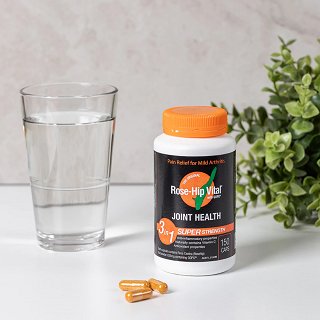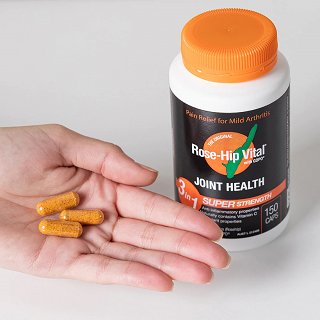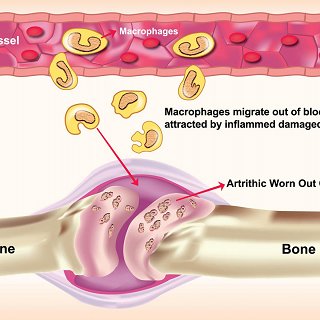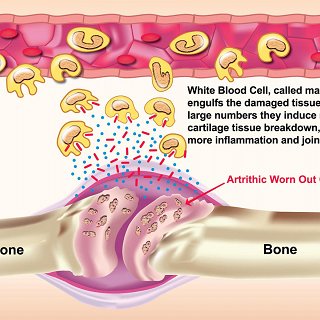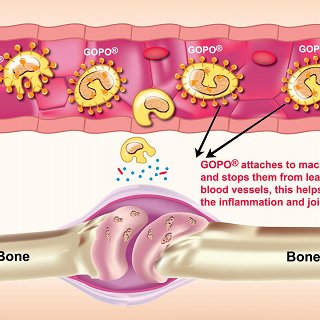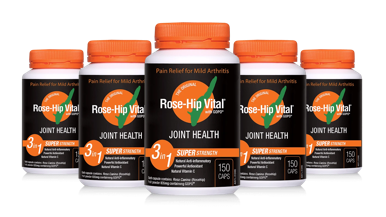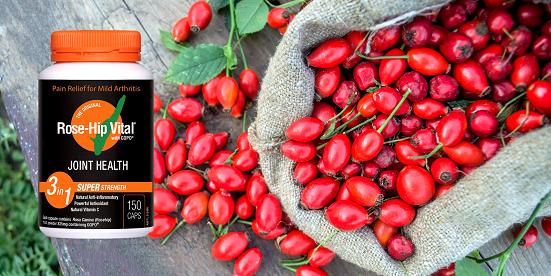Before Agreeing to A Knee Replacement: Have You Considered an Alternative?
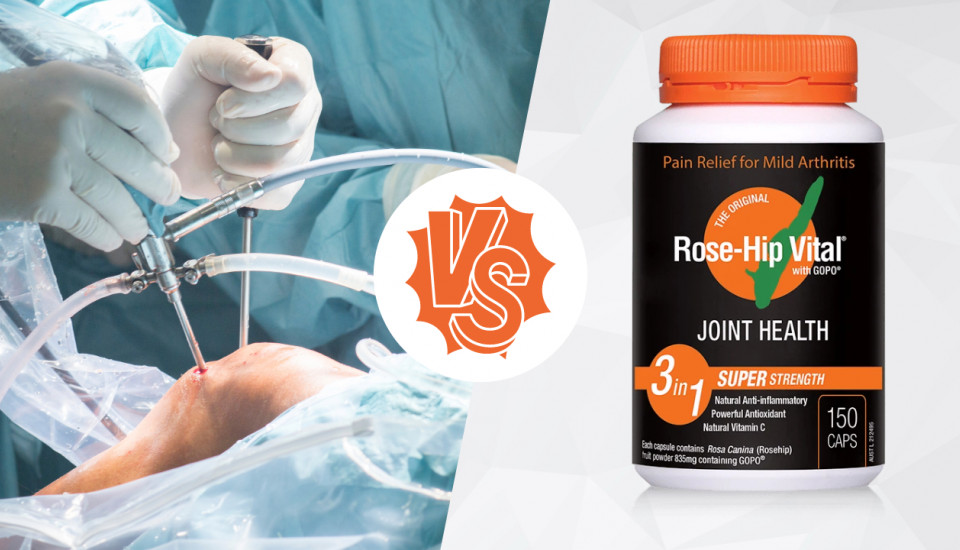
Knee pain can be debilitating, impacting your mobility and quality of life. Often, the thought of a knee replacement looms large as a potential solution. But before you go down that surgical route, let's explore some alternatives, specifically Rose-Hip Vital® with GOPO®.
Why We Get Knee Pain
There are many reasons for knee pain, but the most common culprit is osteoarthritis. This "wear and tear" arthritis occurs when the cartilage that cushions your joints breaks down. This breakdown can be caused by injury, overuse, or simply age. Other factors like obesity, misalignment of the joint, and even genetics can also play a role.
Cartilage Damage: Can We Fix It?
Cartilage is a tough, flexible tissue which covers the ends of bones at joints. Cartilage acts as a cushion and allows bones to move smoothly, reducing friction and preventing them from rubbing against each other. Damaged or worn out cartilage can cause pain, swelling, and loss of motion in the joint.
Cartilage cannot regenerate easily as it lacks a direct blood supply, and its cells (chondrocytes) have limited ability to reproduce and repair damaged tissue.
Unfortunately, there are no known supplements that can rebuild damaged or worn cartilage.
However, there are steps you can take to manage the pain and potentially slow down the progression of damage. These include:
- Weight management: Extra pounds put extra stress on your knees.
- Exercise: Low-impact exercises like swimming or cycling can strengthen the muscles around your knee, providing support and stability.
- Physical therapy: A therapist can teach you exercises and stretches to improve flexibility and range of motion.
Knee Surgery
For some, these conservative measures may not be enough. If surgery is being discussed, there are quite a few options available, such as:
- Arthroscopic Knee Surgery: This minimally invasive procedure involves using a small camera (arthroscope) and specialized instruments inserted through small incisions to diagnose and treat various knee problems, such as torn cartilage (meniscus), ligament injuries (ACL, PCL), and removal of loose bodies. It allows for quicker recovery and less tissue damage compared to open surgery.
- Total Knee Replacement (TKR): Also known as knee arthroplasty, this surgery involves replacing damaged or diseased knee joint surfaces with artificial components made of metal and plastic. It's typically performed for severe arthritis or significant joint damage due to injury. TKR aims to relieve pain, improve function, and restore mobility in the knee.
- Partial Knee Replacement (PKR): In contrast to TKR, PKR involves replacing only the damaged part of the knee joint with an artificial implant, leaving healthy bone and tissue intact. It's suitable for patients with localized arthritis or damage to one compartment of the knee. PKR generally offers quicker recovery and less postoperative pain compared to TKR.
- ACL Reconstruction: Anterior Cruciate Ligament (ACL) reconstruction is performed to repair a torn ACL, a common sports injury. During the procedure, the torn ligament is replaced with a graft (usually from the patient's own hamstring or patellar tendon) to stabilize the knee joint. ACL reconstruction aims to restore knee stability, function, and prevent further damage to the knee structures.
- Meniscus Repair or Meniscectomy: The meniscus is a C-shaped cartilage in the knee that acts as a shock absorber. Meniscus tears are common, especially in athletes. Depending on the type, location, and severity of the tear, surgical intervention may involve either repairing the torn meniscus or removing the damaged portion (meniscectomy). Meniscus repair aims to preserve the meniscus and its function, while meniscectomy may be necessary for irreparable tears or certain types of injuries.
Surgery carries inherent risks and potential complications, ranging from mild to severe. It's important for patients to discuss potential risks and complications with their doctors.
The Power of Rose-Hip Vital® with GOPO®
So while surgery can be effective, it's not always the right answer. Rose-Hip Vital® with GOPO® offers a natural, non-surgical approach to managing knee pain.
The Science Behind Rose-Hip Vital® with GOPO®
Rose-Hip Vital® isn't your average rosehip extract. It's a specific type derived from Rosa canina rosehips and produced using a patented extraction and drying process. This process ensures a high concentration of beneficial compounds, particularly Galactolipids (GOPO®).
GOPO® is exclusive to Rose-Hip Vital®. The active compound was discovered in Denmark and is exclusive to the Rose-Hip Vital® branded powder. Rosehip products without GOPO® have not been shown to have anti-inflammatory properties.
GOPO® - Nature's Anti-Inflammatory Powerhouse
Here's how GOPO® works in Rose-Hip Vital® to combat knee pain:
- Reduces Inflammation: GOPO® works by inhibiting the migration of excess white blood cells to inflamed tissues in your knee. This helps break the cycle of inflammation that contributes to pain and stiffness.
- Protects Cartilage: Inflammation is a major culprit in cartilage breakdown. By reducing inflammation, GOPO® may help protect your existing cartilage and potentially slow down further degeneration.
- Boosts Antioxidants: GOPO® also boasts antioxidant properties. Antioxidants combat free radicals, harmful molecules that can damage your joint health.
For a detailed explanation on how GOPO® works, visit this page.
Clinical Evidence for Pain Relief
Rose-Hip Vital® with GOPO® isn't just backed by science; it's also supported by clinical research. Multiple studies, including double-blind placebo-controlled trials, have demonstrated its effectiveness in managing osteoarthritis pain. These studies have shown that Rose-Hip Vital® with GOPO® can:
- Reduce pain intensity: Participants in studies reported significant reductions in knee pain compared to a placebo.
- Improve joint mobility: Increased flexibility and range of motion were observed in those taking Rose-Hip Vital® with GOPO®.
- Decrease need for pain medication: Studies suggest that Rose-Hip Vital® with GOPO® may help reduce reliance on pain medication.
It is important to remember that like ALL other joint supplements on the market, Rose-Hip Vital® is unable to repair damaged cartilage, but it may prevent further cartilage loss by arresting and breaking the cycle of the inflammation. Excessive or uncontrolled inflammation can lead to further tissue damage, and the patented compound GOPO® in Rose-Hip Vital® works by preventing excessive white blood cell accumulation at the affected area. Rose-Hip Vital® may also help with the pain caused by cartilage damage and bone-on-bone friction.
A Safe and Natural Approach
Rose-Hip Vital® with GOPO® offers a safe and natural alternative to manage knee pain. Unlike some pain medications, it's generally well-tolerated with minimal side effects. This makes it a suitable option for those who want to avoid harsh chemicals or are concerned about the risks associated with surgery.
Take Charge of Your Knee Health
Knee pain doesn't have to control your life. Explore natural options like Rose-Hip Vital® with GOPO® alongside conservative measures and potentially avoid the need for surgery. By taking a proactive approach to your knee health, you can regain mobility, reduce pain, and get back to enjoying an active life.
